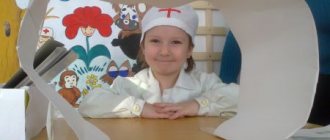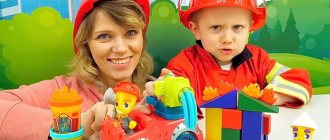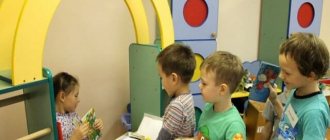Summary of the role-playing game “Bus trip to the zoo”
Summary of the role-playing game “A trip by bus to the zoo” in the senior group.
Target:
systematize children’s existing knowledge and skills about the rules of safe behavior in public places based on the role-playing game “Traveling by Bus to the Zoo.”
Tasks:
continue to develop in children the ability to perform game actions in accordance with the game plan; activate dialogic speech; encourage initiative and independence, strengthen friendly relationships during gaming activities.
Preliminary work:
a series of lessons from the “Safety” series; examination of illustrations on the topic: “Traffic rules”, “Modes of transport”, “Zoo”, “Animals of forests”, “Animals of hot countries”; reading fiction (stories, poems, riddles) S. Marshak “Zoo”, “Children in a Cage”; L. Shevchenko “At the Zoo”; K. Chukovsky “Aibolit”; didactic games: “Attention on the roads”, “Road signs”, “Safe walks”, “Who lives where?”, “Such different animals”, “Zoological lotto”; production of albums “Transport”, “Animals of hot countries”, “Animals of forests”; acquaintance with illustrations by S. Nikolaeva and N. Meshkova from the series “The World Around Us. Beasts"; conversations with children about visiting the zoo in the summer with their parents, about the professions of people working in the zoo; conversations about the characteristics of the animal world and other climatic zones.
Vocabulary work:
freight transport, passenger transport, conductor, driver; veterinarian, zoo, aviary, cashier.
Roles:
bus driver, conductor, cashier, “please”, “thank you”.
Subject-spatial environment:
toys - animals (at least 16 pieces), a designer to build enclosures, a model of a bus, a steering wheel for the driver, a conductor's bag, a model of a ticket office, tickets for the bus and to the zoo, "money".
Methods and techniques:
explanations, story, questions, playing out roles and game situations, riddles, the didactic game “Guess what sign”, the sedentary game “At the Bear in the Forest”.
Progress of the game
A teacher stands at the window with children
-November-late autumn has arrived. It’s very cold outside and everything in nature is preparing for winter. And I would really like to visit a place where you can see forest animals and animals of hot countries, regardless of the weather.
The children suggest going to the zoo. The teacher supports the children's initiative. Everyone together begins to build enclosures from the construction set and place animals (toys) in them, and set up a model of the cash register.
-How can you get to the zoo, maybe by car? (children, he is too small for us)
-But then on a truck? (Children trucks transport goods, not people)
Summary of the role-playing game “Excursion to the Zoo”
Transcript
1 MADOU Luzhnikovsky combined kindergarten “Cherry” in the Stupinsky municipal district. Summary of the role-playing game “Excursion to the Zoo” for the middle group “Sun”. Prepared and conducted by: teacher Karpenko E.E. November 2016
2 Goal: To develop gaming competencies, the ability to enter into role-playing interactions with each other. To consolidate children's knowledge about zoo representatives. Objectives: 1. Learn to jointly carry out what is planned, develop the ability to perform game actions in accordance with the role taken. Expand children's understanding of adult professions. 2. To develop in children a creative attitude to play, the ability to use substitute objects; 3. Foster a culture of communication, friendly relationships, and respect for the work of adults. Preliminary work: - Conversations about animals, looking at illustrations with images of various animals. - Reading poems by S. Marshak “Children in a Cage”, stories about animals by V. Chaplina, B. Zhitkov, V. Bianki. — Viewing presentations about animals from different countries. — Finger and speech games about animals, — Solving riddles about animals, — Productive activities: drawing, modeling, coloring representatives of the animal world. Subject-game environment. Equipment and attributes: Building material for the construction of enclosures for animals, a steering wheel for the driver, a truck, animal toys, prohibitory signs in the zoo, a cash register, tickets, a microphone, a tape recorder, puzzles with images of animals, equipment for the game “Veterinary Hospital”, an apron, dishes, badges for the guide, audiogram of the song “Zoo” (music and lyrics by M. Liberov) Vocabulary work: “zoo, aviary, caretaker, veterinarian” Roles played: Children bus driver, cashier, veterinarian, builders, truck driver, caretaker, tour guide . Teacher presenter, interviewer (correspondent).
3 I. Organizational moment. Progress of the game. Guys, today we have a journey ahead of us and before departure I suggest you warm up a little. Game “Please” Educator: I will give you various tasks, and you will have to complete these tasks only if I say the magic word “please” - Raise your right hand, please. - Clap your hands - Sit down. (spin, etc.) Well done! Now I see that you are ready for the journey II. 1. Guys, I accidentally scattered the pictures, they need to be put into folders. See how they can be classified (divided into groups: wild and domestic animals) - Where do domestic animals live? (at home, in the yard, in sheds, on farms) - Where can we see wild animals? (in the forest, at the zoo) And now we will go with you to the zoo. (We are riding a bus, we choose a driver, the driver announces a stop) Children sit on chairs, the driver is sitting in front, the steering wheel is in his hands (Vladik S) We are sitting on the bus We look out of the window To the left, look to the right Don’t miss anything. Stop. Come out. And look outside. (the driver announces the “Zoo” stop) 2. Educator: To go to the zoo you need to build it. First, the Builders (Nastya L. Artem R. and Egor K.) build enclosures for the animals. — Order in the zoo is monitored by a special human employee, the zookeeper. He also feeds the animals. We appoint a caretaker. (Vanya S.)
4 Now we need to bring the animals and place them in new enclosures: the driver (Pasha S.) brings a box with animals by car. _ In order to find out what animals were brought to the zoo, we need to solve riddles: 1) Jumps across the field, hides its ears, Stands up like a pillar, ears upright. (hare) 2) The owner of the forest, wakes up in the spring, And in winter he sleeps in a snowy hut under a blizzard howl. (bear) 3) Who gnawed the pine cones on the branch and threw the scraps down? Who deftly jumps through the fir trees and flies up into the oak trees? Who hides nuts in a hollow and dries mushrooms for the winter? (squirrel) 4) Like a Christmas tree, covered in needles! (hedgehog) Children guess the animals, take them out of the car and the caretaker puts them in enclosures. Educator: Animals in the zoo must be healthy, their condition is monitored by a special veterinarian (Arina Stepina). The veterinarian examines the animals and reports that it is possible to conduct an excursion. III. 1. Dynamic pause “Zoo” We are walking into the zoo, - We are walking on the spot. Everyone is happy to be there! There are bears and penguins, Parrots and peacocks, There are giraffes and elephants, Monkeys, tigers, lions. - turns the body with outstretched arms. - jumping in place - arms up and to the sides - squats, hands on the belt We all have fun playing and performing movements. - Claps.
5 2. Educator: To go to the zoo on an excursion, you need to buy tickets. The cashier sells tickets. Children buy a ticket and sit on chairs. The guide (Dasha Ya.) invites you to go to the zoo to the enclosure with animals and tells an interesting fact about the animals (Appendix 1) (Child prepared in advance) Educator: Thanks to the guide, and now the animals will be fed (The zookeeper feeds the animals, and the children watch) . The teacher draws attention to the fact that animals in the zoo cannot be fed, because visitors do not always treat the animals with healthy foods, and to prevent the animals from getting sick, it is forbidden to feed them. 3. Didactic game “Who’s Hiding” What other animals can you see in the zoo? (name 3-4) Now I propose to collect the inhabitants of the zoo from puzzles (4-5 pieces) Now close your eyes, one animal will hide, and you must guess who is hiding. 4. Finger gymnastics “Friendship of Animals” Good animals are friends. — Fingers locked. Small bunnies are friends. rhythmic touches with little fingers Beavers are friends in the lake. Mosquitoes are friends in the sky. Cute hedgehogs are friends. rhythmic touching with ring fingers -. Middle fingers -. Even bear cubs are friends with their index fingers. - thumbs That's how they played out, they ran through the forest! - shake your hands. IV. Result: game situation “interview”. (the teacher takes the microphone and puts on a cap) - Hello, I am a correspondent for the newspaper “Luzhnikovskie Vesti”, I want to interview you. Tell me, did you like the excursion to the zoo? — What animals live in the zoo? (wild) - What interesting things have you learned about animals? (children's answers)
6 Appendix 1!
7 Appendix 2 Guide: Daria Guide: Arina



